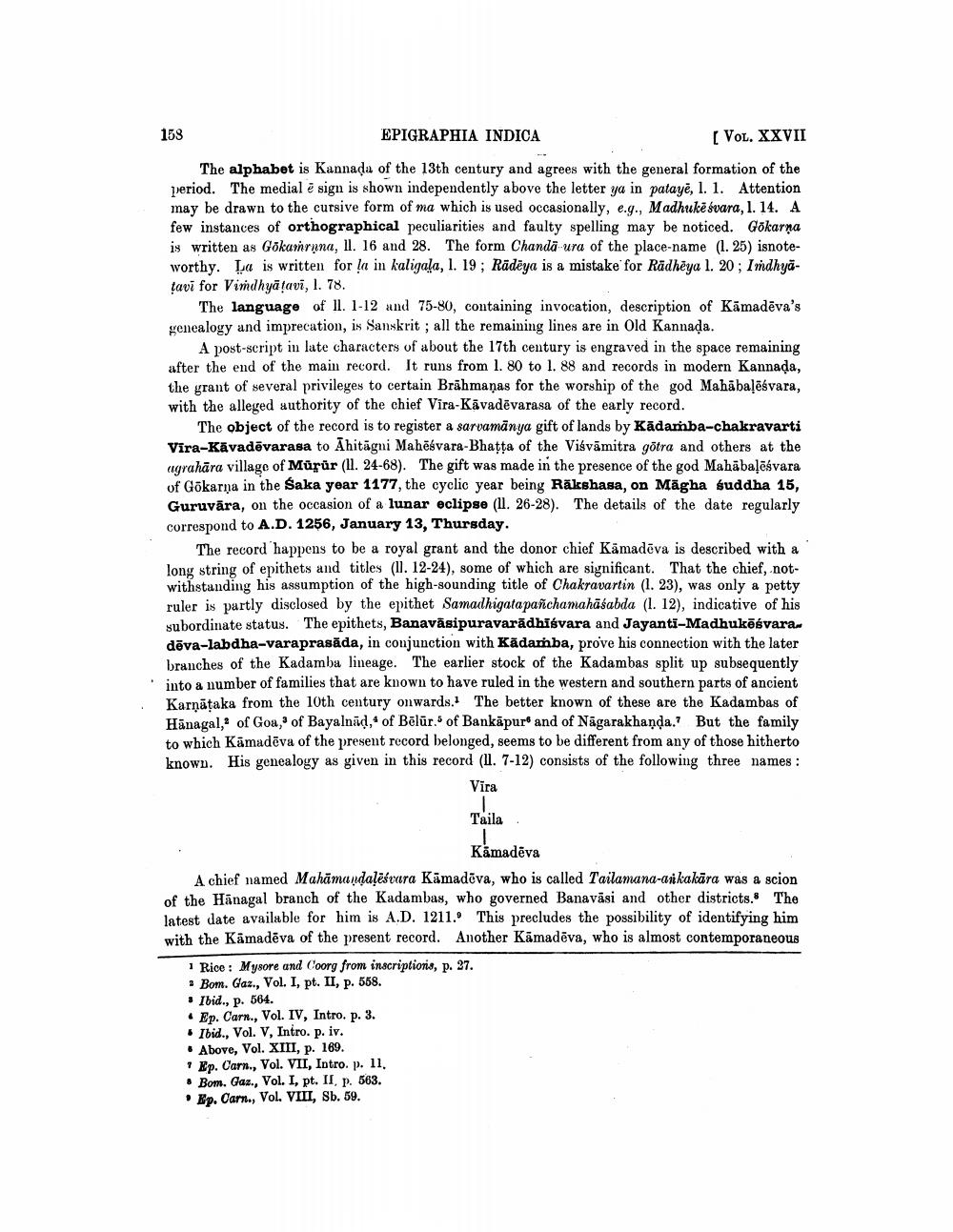________________
158
EPIGRAPHIA INDICA
[ Vol. XXVII
The alphabet is Kannada of the 13th century and agrees with the general formation of the period. The medial é sign is shown independently above the letter ya in pataye, 1. 1. Attention may be drawn to the cursive form of ma which is used occasionally, e.g., Madhukē švara, 1. 14. A few instances of orthographical peculiarities and faulty spelling may be noticed. Gokarna is written as Gökamrana, ll. 16 and 28. The form Chandā ura of the place-name (1.25) isnoteworthy. La is written for lain kaligaļa, 1. 19; Rādeya is a mistake for Rādhęya l. 20; Imdhyaļavi for Vimdhyā tavi, 1. 78.
The language of 11. 1-12 and 75-80, containing invocation, description of Kāmadēva's genealogy and imprecation, is Sanskrit ; all the remaining lines are in Old Kannada.
A post-script in late characters of about the 17th century is engraved in the space remaining after the end of the main record. It runs from 1. 80 to l. 88 and records in modern Kannada, the grant of several privileges to certain Brāhmaṇas for the worship of the god Mahābaļēśvara, with the alleged authority of the chief Vira-Kāvadēvarasa of the early record.
The object of the record is to register a sarvamanya gift of lands by Kādamba-chakravarti Vira-Kavadēvarasa to āhitāgni Mahēsvara-Bhatta of the Visvāmitra götra and others at the agrahāra village of Mūrür (Il. 24-68). The gift was made in the presence of the god Mahābaļēsvara of Gökarna in the Saka year 1177, the cyclic year being Rākshasa, on Māgha suddha 15, Guruvāra, on the occasion of a lunar eclipse (1l. 26-28). The details of the date regularly correspond to A.D. 1256, January 13, Thursday.
The record happens to be a royal grant and the donor chief Kāmadēva is described with a long string of epithets and titles (11. 12-24), some of which are significant. That the chief, notwithstanding his assumption of the high-sounding title of Chakravartin (1. 23), was only a petty ruler is partly disclosed by the epithet Samadhigatapañchamahāśabda (1. 12), indicative of his subordinate status. The epithets, Banavāsipuravarādhīśvara and Jayanti-Madhukēśvara. dēva-labdha-varaprasāda, in conjunction with Kādamba, prove his connection with the later branches of the Kadamba lineage. The earlier stock of the Kadambas split up subsequently into a number of families that are known to have ruled in the western and southern parts of ancient Karnataka from the 10th century onwards. The better known of these are the Kadambas of Hānagal, of Goa, of Bayalnūd," of Bēlür.. of Bankāpur and of Nāgarakhanda.? But the family to which Kāmadova of the present record belonged, seems to be different from any of those hitherto known. His genealogy as given in this record (11. 7-12) consists of the following three names :
Vira
Taila
Kámadēva A chief named Mahämandalesvara Kamadova, who is called Tailamana-asikakära was a scion of the Hanagal branch of the Kadambas, who governed Banavasi and other districts. The latest date available for him is A.D. 1211.° This precludes the possibility of identifying him with the Kämadēva of the present record. Another Kāmadēva, who is almost contemporaneous
1 Rice : Mysore and Coorg from inscriptions, p. 37. * Bom. Gaz., Vol. I, pt. II, p. 558. • Ibid., p. 564. • Ep. Carn., Vol. IV, Intro. p. 3.
Ibid., Vol. V, Intro. p. iv. * Above, Vol. XIII, p. 169. * Ep. Carn., Vol. VII, Intro. p. 11. • Bom. Gaz., Vol. I, pt. II. p. 563. • Ep. Carn., Vol. VIII, Sb. 59.




